Strategic Information Systems in Libraries: A Comprehensive Report
VerifiedAdded on 2021/06/15
|15
|4031
|71
Report
AI Summary
This report provides a comprehensive overview of information systems within libraries. It begins by outlining the business processes involved in library management, including data management, payment processing, stock management, and search functions. The report then details the business requirements necessary to support these processes, emphasizing the importance of information management. It further explores system requirements for automated information systems, such as login functionality, catalog systems, and payment gateways, alongside crucial non-functional requirements like performance, reliability, and security. The report then delves into software and vendor selection, examining options like Insignia Software, OPALS, Koha, and Libero, highlighting their features and benefits. It also discusses system acquisition methods, including package purchasing, outsourcing, and custom-developed software, along with their respective efficiencies and drawbacks. Finally, the report addresses potential security risks and data breaches, offering protection measures and concluding with recommendations for effective implementation of information systems in libraries.

Paraphrase This Document
Need a fresh take? Get an instant paraphrase of this document with our AI Paraphraser
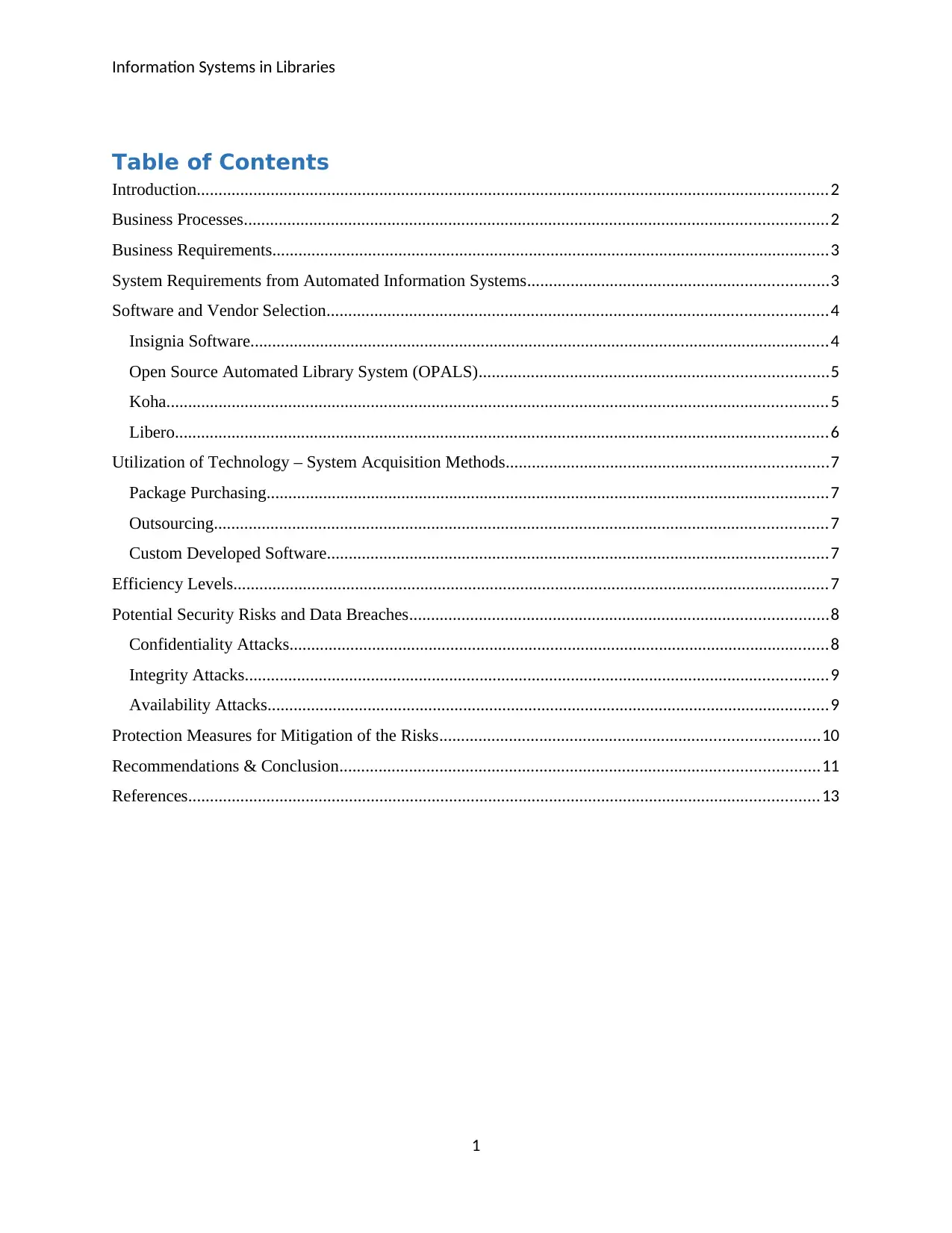
Information Systems in Libraries
Table of Contents
Introduction.................................................................................................................................................2
Business Processes......................................................................................................................................2
Business Requirements................................................................................................................................3
System Requirements from Automated Information Systems.....................................................................3
Software and Vendor Selection...................................................................................................................4
Insignia Software.....................................................................................................................................4
Open Source Automated Library System (OPALS)................................................................................5
Koha........................................................................................................................................................5
Libero......................................................................................................................................................6
Utilization of Technology – System Acquisition Methods..........................................................................7
Package Purchasing.................................................................................................................................7
Outsourcing.............................................................................................................................................7
Custom Developed Software...................................................................................................................7
Efficiency Levels.........................................................................................................................................7
Potential Security Risks and Data Breaches................................................................................................8
Confidentiality Attacks............................................................................................................................8
Integrity Attacks......................................................................................................................................9
Availability Attacks.................................................................................................................................9
Protection Measures for Mitigation of the Risks.......................................................................................10
Recommendations & Conclusion..............................................................................................................11
References.................................................................................................................................................13
1
Table of Contents
Introduction.................................................................................................................................................2
Business Processes......................................................................................................................................2
Business Requirements................................................................................................................................3
System Requirements from Automated Information Systems.....................................................................3
Software and Vendor Selection...................................................................................................................4
Insignia Software.....................................................................................................................................4
Open Source Automated Library System (OPALS)................................................................................5
Koha........................................................................................................................................................5
Libero......................................................................................................................................................6
Utilization of Technology – System Acquisition Methods..........................................................................7
Package Purchasing.................................................................................................................................7
Outsourcing.............................................................................................................................................7
Custom Developed Software...................................................................................................................7
Efficiency Levels.........................................................................................................................................7
Potential Security Risks and Data Breaches................................................................................................8
Confidentiality Attacks............................................................................................................................8
Integrity Attacks......................................................................................................................................9
Availability Attacks.................................................................................................................................9
Protection Measures for Mitigation of the Risks.......................................................................................10
Recommendations & Conclusion..............................................................................................................11
References.................................................................................................................................................13
1
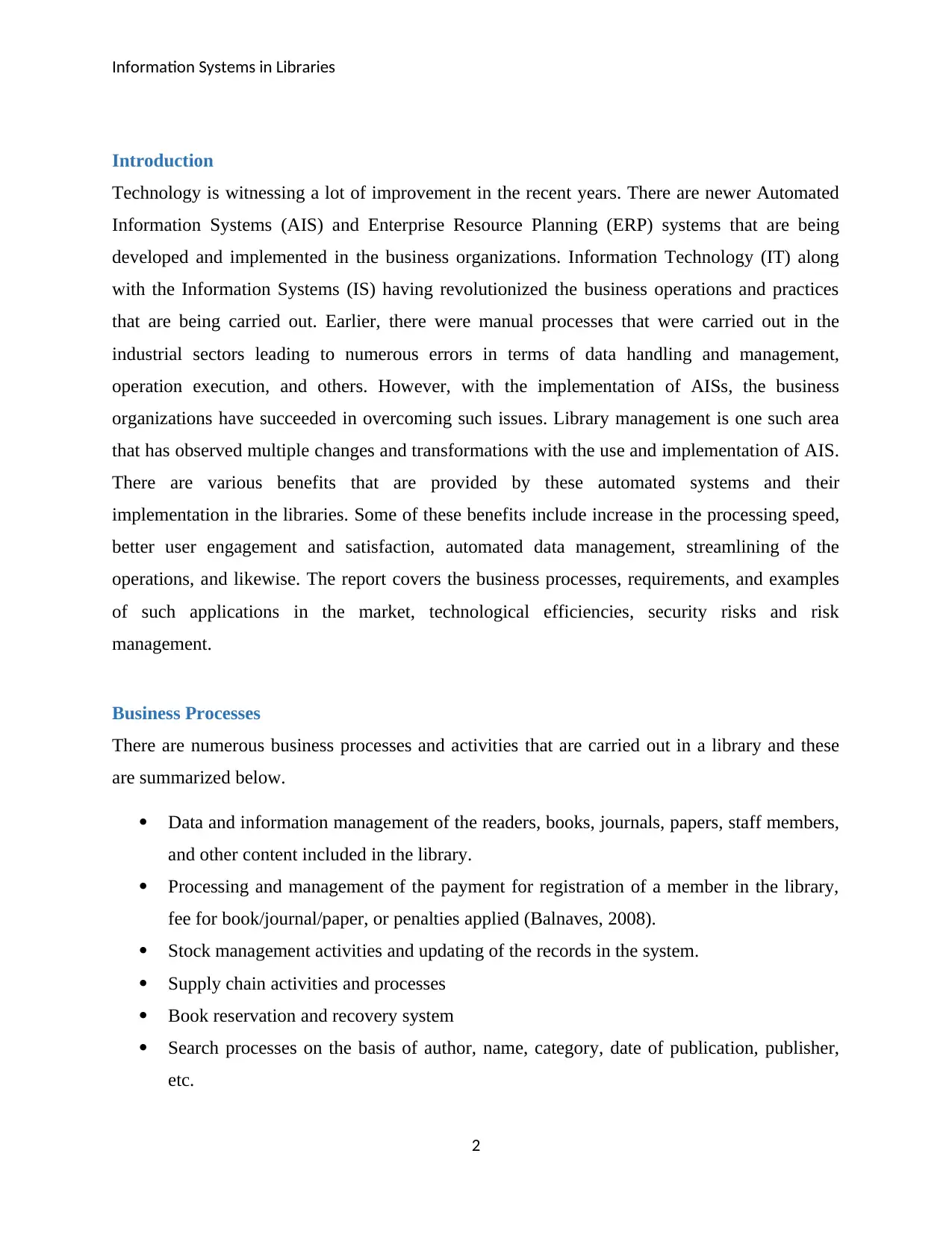
Information Systems in Libraries
Introduction
Technology is witnessing a lot of improvement in the recent years. There are newer Automated
Information Systems (AIS) and Enterprise Resource Planning (ERP) systems that are being
developed and implemented in the business organizations. Information Technology (IT) along
with the Information Systems (IS) having revolutionized the business operations and practices
that are being carried out. Earlier, there were manual processes that were carried out in the
industrial sectors leading to numerous errors in terms of data handling and management,
operation execution, and others. However, with the implementation of AISs, the business
organizations have succeeded in overcoming such issues. Library management is one such area
that has observed multiple changes and transformations with the use and implementation of AIS.
There are various benefits that are provided by these automated systems and their
implementation in the libraries. Some of these benefits include increase in the processing speed,
better user engagement and satisfaction, automated data management, streamlining of the
operations, and likewise. The report covers the business processes, requirements, and examples
of such applications in the market, technological efficiencies, security risks and risk
management.
Business Processes
There are numerous business processes and activities that are carried out in a library and these
are summarized below.
Data and information management of the readers, books, journals, papers, staff members,
and other content included in the library.
Processing and management of the payment for registration of a member in the library,
fee for book/journal/paper, or penalties applied (Balnaves, 2008).
Stock management activities and updating of the records in the system.
Supply chain activities and processes
Book reservation and recovery system
Search processes on the basis of author, name, category, date of publication, publisher,
etc.
2
Introduction
Technology is witnessing a lot of improvement in the recent years. There are newer Automated
Information Systems (AIS) and Enterprise Resource Planning (ERP) systems that are being
developed and implemented in the business organizations. Information Technology (IT) along
with the Information Systems (IS) having revolutionized the business operations and practices
that are being carried out. Earlier, there were manual processes that were carried out in the
industrial sectors leading to numerous errors in terms of data handling and management,
operation execution, and others. However, with the implementation of AISs, the business
organizations have succeeded in overcoming such issues. Library management is one such area
that has observed multiple changes and transformations with the use and implementation of AIS.
There are various benefits that are provided by these automated systems and their
implementation in the libraries. Some of these benefits include increase in the processing speed,
better user engagement and satisfaction, automated data management, streamlining of the
operations, and likewise. The report covers the business processes, requirements, and examples
of such applications in the market, technological efficiencies, security risks and risk
management.
Business Processes
There are numerous business processes and activities that are carried out in a library and these
are summarized below.
Data and information management of the readers, books, journals, papers, staff members,
and other content included in the library.
Processing and management of the payment for registration of a member in the library,
fee for book/journal/paper, or penalties applied (Balnaves, 2008).
Stock management activities and updating of the records in the system.
Supply chain activities and processes
Book reservation and recovery system
Search processes on the basis of author, name, category, date of publication, publisher,
etc.
2
⊘ This is a preview!⊘
Do you want full access?
Subscribe today to unlock all pages.

Trusted by 1+ million students worldwide
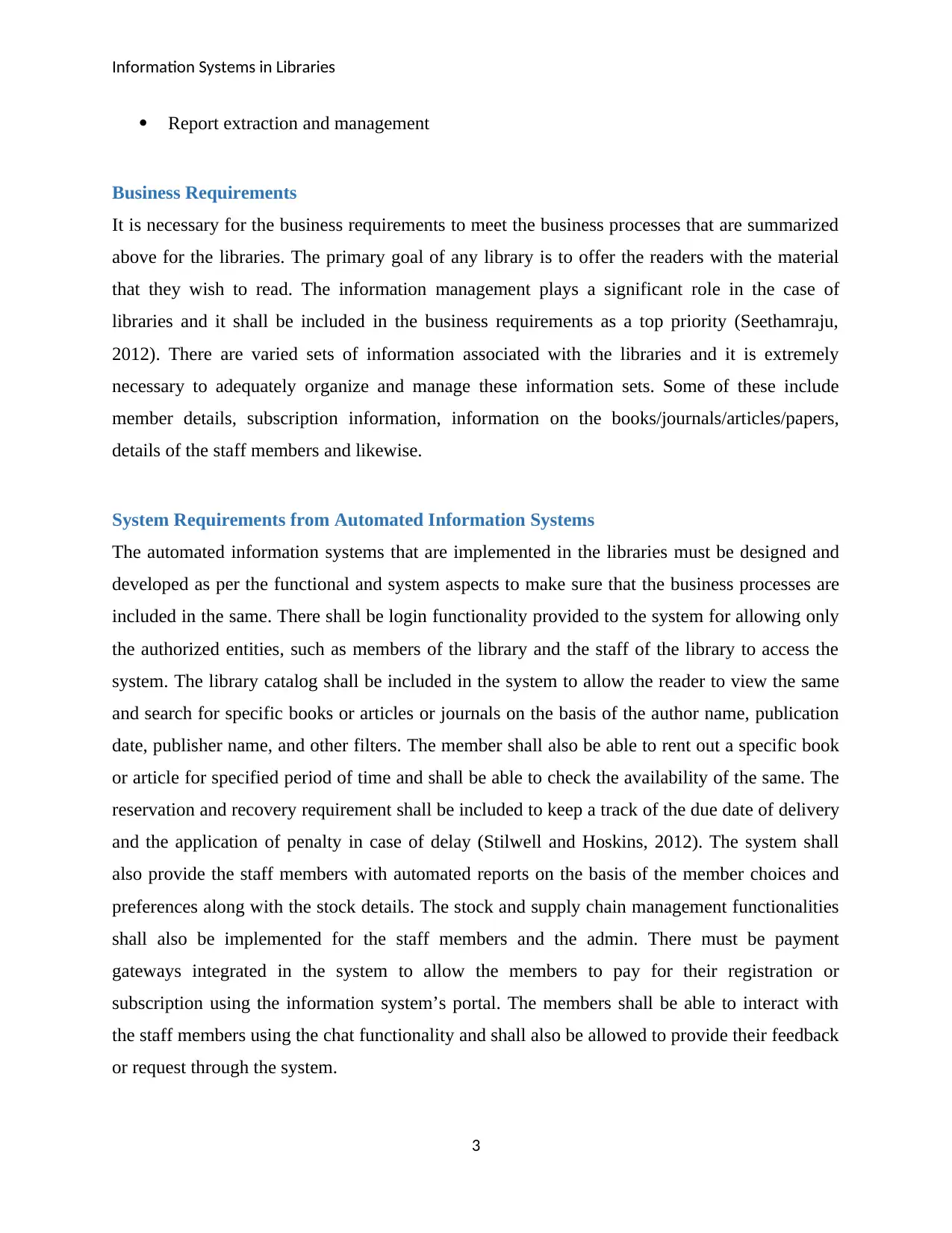
Information Systems in Libraries
Report extraction and management
Business Requirements
It is necessary for the business requirements to meet the business processes that are summarized
above for the libraries. The primary goal of any library is to offer the readers with the material
that they wish to read. The information management plays a significant role in the case of
libraries and it shall be included in the business requirements as a top priority (Seethamraju,
2012). There are varied sets of information associated with the libraries and it is extremely
necessary to adequately organize and manage these information sets. Some of these include
member details, subscription information, information on the books/journals/articles/papers,
details of the staff members and likewise.
System Requirements from Automated Information Systems
The automated information systems that are implemented in the libraries must be designed and
developed as per the functional and system aspects to make sure that the business processes are
included in the same. There shall be login functionality provided to the system for allowing only
the authorized entities, such as members of the library and the staff of the library to access the
system. The library catalog shall be included in the system to allow the reader to view the same
and search for specific books or articles or journals on the basis of the author name, publication
date, publisher name, and other filters. The member shall also be able to rent out a specific book
or article for specified period of time and shall be able to check the availability of the same. The
reservation and recovery requirement shall be included to keep a track of the due date of delivery
and the application of penalty in case of delay (Stilwell and Hoskins, 2012). The system shall
also provide the staff members with automated reports on the basis of the member choices and
preferences along with the stock details. The stock and supply chain management functionalities
shall also be implemented for the staff members and the admin. There must be payment
gateways integrated in the system to allow the members to pay for their registration or
subscription using the information system’s portal. The members shall be able to interact with
the staff members using the chat functionality and shall also be allowed to provide their feedback
or request through the system.
3
Report extraction and management
Business Requirements
It is necessary for the business requirements to meet the business processes that are summarized
above for the libraries. The primary goal of any library is to offer the readers with the material
that they wish to read. The information management plays a significant role in the case of
libraries and it shall be included in the business requirements as a top priority (Seethamraju,
2012). There are varied sets of information associated with the libraries and it is extremely
necessary to adequately organize and manage these information sets. Some of these include
member details, subscription information, information on the books/journals/articles/papers,
details of the staff members and likewise.
System Requirements from Automated Information Systems
The automated information systems that are implemented in the libraries must be designed and
developed as per the functional and system aspects to make sure that the business processes are
included in the same. There shall be login functionality provided to the system for allowing only
the authorized entities, such as members of the library and the staff of the library to access the
system. The library catalog shall be included in the system to allow the reader to view the same
and search for specific books or articles or journals on the basis of the author name, publication
date, publisher name, and other filters. The member shall also be able to rent out a specific book
or article for specified period of time and shall be able to check the availability of the same. The
reservation and recovery requirement shall be included to keep a track of the due date of delivery
and the application of penalty in case of delay (Stilwell and Hoskins, 2012). The system shall
also provide the staff members with automated reports on the basis of the member choices and
preferences along with the stock details. The stock and supply chain management functionalities
shall also be implemented for the staff members and the admin. There must be payment
gateways integrated in the system to allow the members to pay for their registration or
subscription using the information system’s portal. The members shall be able to interact with
the staff members using the chat functionality and shall also be allowed to provide their feedback
or request through the system.
3
Paraphrase This Document
Need a fresh take? Get an instant paraphrase of this document with our AI Paraphraser
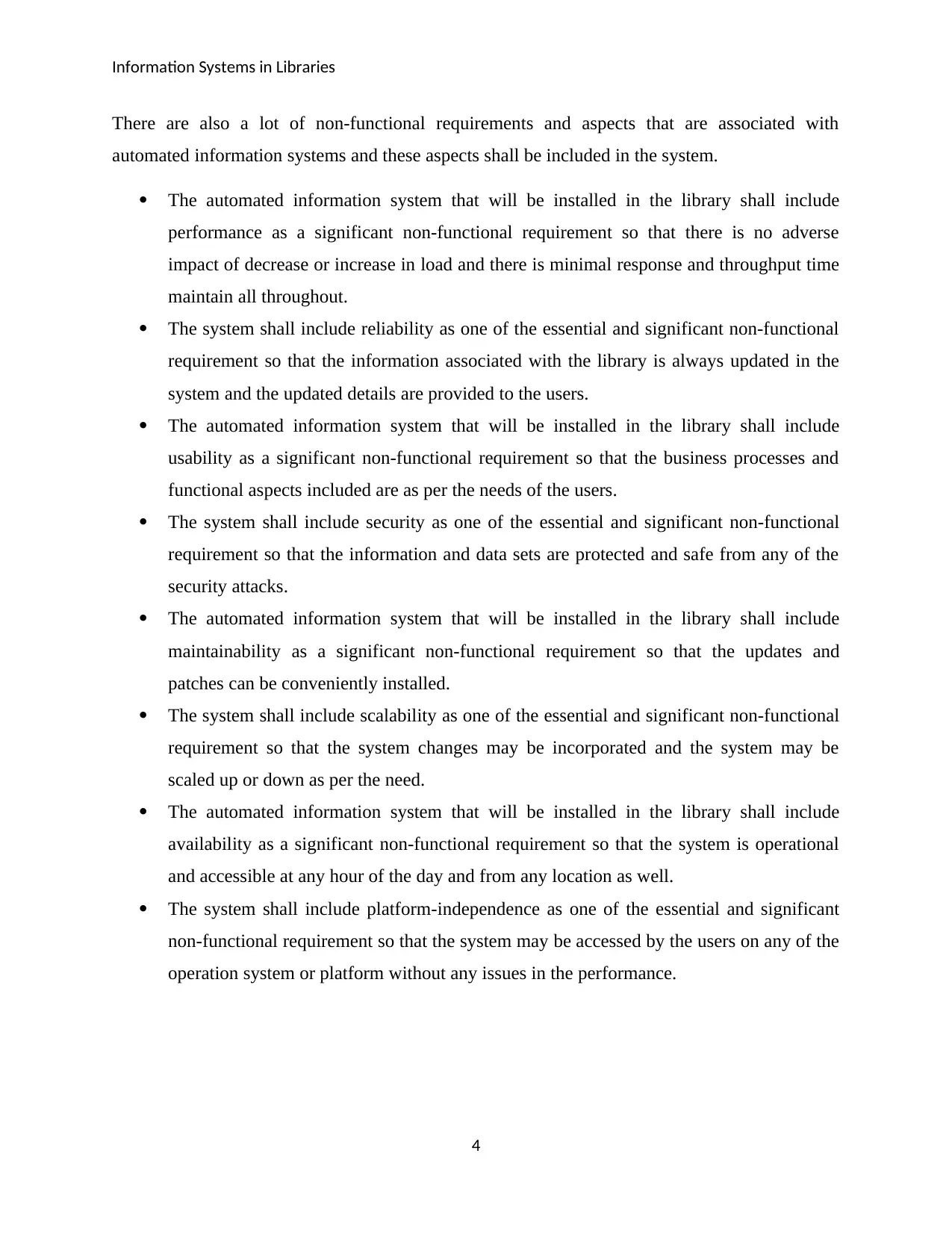
Information Systems in Libraries
There are also a lot of non-functional requirements and aspects that are associated with
automated information systems and these aspects shall be included in the system.
The automated information system that will be installed in the library shall include
performance as a significant non-functional requirement so that there is no adverse
impact of decrease or increase in load and there is minimal response and throughput time
maintain all throughout.
The system shall include reliability as one of the essential and significant non-functional
requirement so that the information associated with the library is always updated in the
system and the updated details are provided to the users.
The automated information system that will be installed in the library shall include
usability as a significant non-functional requirement so that the business processes and
functional aspects included are as per the needs of the users.
The system shall include security as one of the essential and significant non-functional
requirement so that the information and data sets are protected and safe from any of the
security attacks.
The automated information system that will be installed in the library shall include
maintainability as a significant non-functional requirement so that the updates and
patches can be conveniently installed.
The system shall include scalability as one of the essential and significant non-functional
requirement so that the system changes may be incorporated and the system may be
scaled up or down as per the need.
The automated information system that will be installed in the library shall include
availability as a significant non-functional requirement so that the system is operational
and accessible at any hour of the day and from any location as well.
The system shall include platform-independence as one of the essential and significant
non-functional requirement so that the system may be accessed by the users on any of the
operation system or platform without any issues in the performance.
4
There are also a lot of non-functional requirements and aspects that are associated with
automated information systems and these aspects shall be included in the system.
The automated information system that will be installed in the library shall include
performance as a significant non-functional requirement so that there is no adverse
impact of decrease or increase in load and there is minimal response and throughput time
maintain all throughout.
The system shall include reliability as one of the essential and significant non-functional
requirement so that the information associated with the library is always updated in the
system and the updated details are provided to the users.
The automated information system that will be installed in the library shall include
usability as a significant non-functional requirement so that the business processes and
functional aspects included are as per the needs of the users.
The system shall include security as one of the essential and significant non-functional
requirement so that the information and data sets are protected and safe from any of the
security attacks.
The automated information system that will be installed in the library shall include
maintainability as a significant non-functional requirement so that the updates and
patches can be conveniently installed.
The system shall include scalability as one of the essential and significant non-functional
requirement so that the system changes may be incorporated and the system may be
scaled up or down as per the need.
The automated information system that will be installed in the library shall include
availability as a significant non-functional requirement so that the system is operational
and accessible at any hour of the day and from any location as well.
The system shall include platform-independence as one of the essential and significant
non-functional requirement so that the system may be accessed by the users on any of the
operation system or platform without any issues in the performance.
4
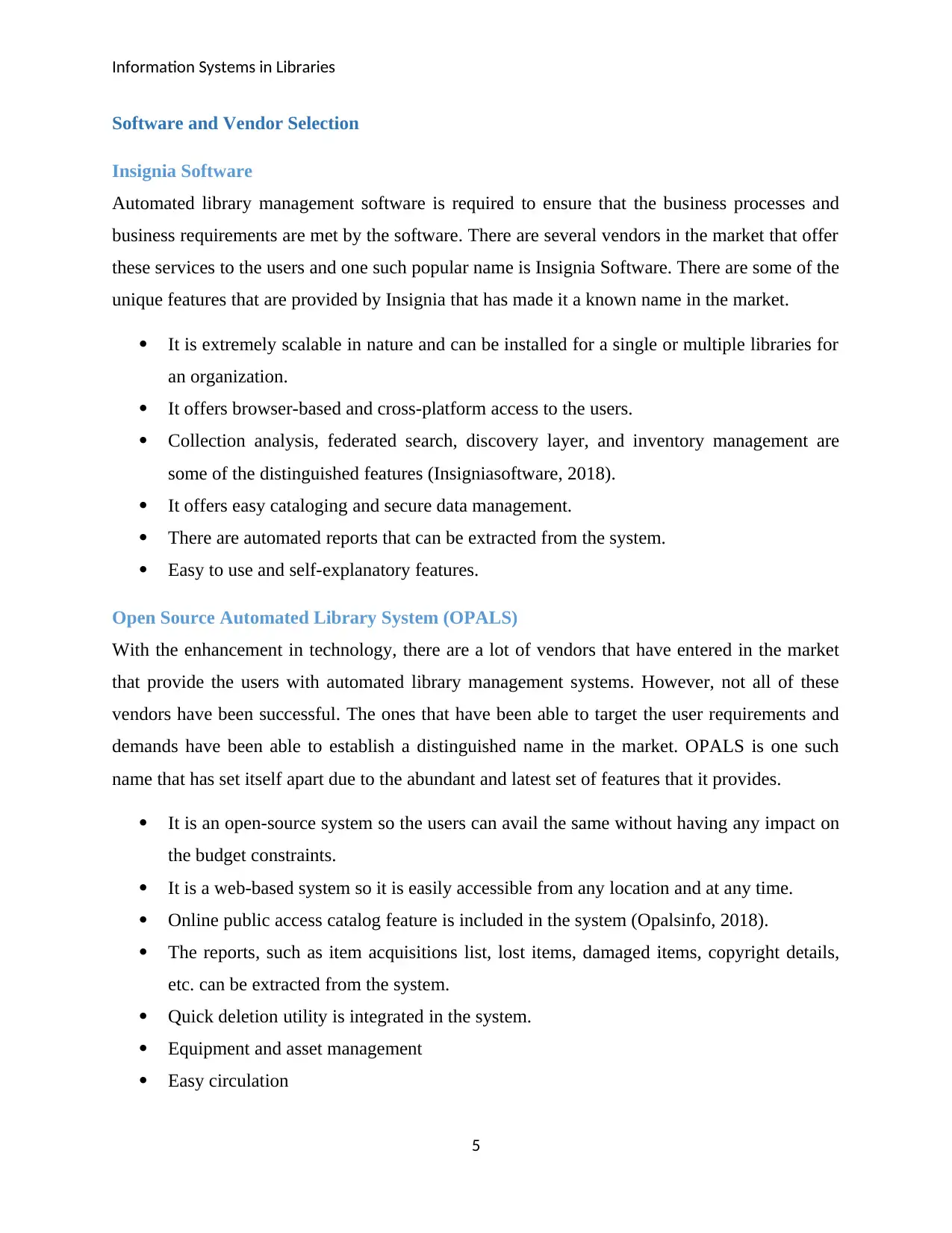
Information Systems in Libraries
Software and Vendor Selection
Insignia Software
Automated library management software is required to ensure that the business processes and
business requirements are met by the software. There are several vendors in the market that offer
these services to the users and one such popular name is Insignia Software. There are some of the
unique features that are provided by Insignia that has made it a known name in the market.
It is extremely scalable in nature and can be installed for a single or multiple libraries for
an organization.
It offers browser-based and cross-platform access to the users.
Collection analysis, federated search, discovery layer, and inventory management are
some of the distinguished features (Insigniasoftware, 2018).
It offers easy cataloging and secure data management.
There are automated reports that can be extracted from the system.
Easy to use and self-explanatory features.
Open Source Automated Library System (OPALS)
With the enhancement in technology, there are a lot of vendors that have entered in the market
that provide the users with automated library management systems. However, not all of these
vendors have been successful. The ones that have been able to target the user requirements and
demands have been able to establish a distinguished name in the market. OPALS is one such
name that has set itself apart due to the abundant and latest set of features that it provides.
It is an open-source system so the users can avail the same without having any impact on
the budget constraints.
It is a web-based system so it is easily accessible from any location and at any time.
Online public access catalog feature is included in the system (Opalsinfo, 2018).
The reports, such as item acquisitions list, lost items, damaged items, copyright details,
etc. can be extracted from the system.
Quick deletion utility is integrated in the system.
Equipment and asset management
Easy circulation
5
Software and Vendor Selection
Insignia Software
Automated library management software is required to ensure that the business processes and
business requirements are met by the software. There are several vendors in the market that offer
these services to the users and one such popular name is Insignia Software. There are some of the
unique features that are provided by Insignia that has made it a known name in the market.
It is extremely scalable in nature and can be installed for a single or multiple libraries for
an organization.
It offers browser-based and cross-platform access to the users.
Collection analysis, federated search, discovery layer, and inventory management are
some of the distinguished features (Insigniasoftware, 2018).
It offers easy cataloging and secure data management.
There are automated reports that can be extracted from the system.
Easy to use and self-explanatory features.
Open Source Automated Library System (OPALS)
With the enhancement in technology, there are a lot of vendors that have entered in the market
that provide the users with automated library management systems. However, not all of these
vendors have been successful. The ones that have been able to target the user requirements and
demands have been able to establish a distinguished name in the market. OPALS is one such
name that has set itself apart due to the abundant and latest set of features that it provides.
It is an open-source system so the users can avail the same without having any impact on
the budget constraints.
It is a web-based system so it is easily accessible from any location and at any time.
Online public access catalog feature is included in the system (Opalsinfo, 2018).
The reports, such as item acquisitions list, lost items, damaged items, copyright details,
etc. can be extracted from the system.
Quick deletion utility is integrated in the system.
Equipment and asset management
Easy circulation
5
⊘ This is a preview!⊘
Do you want full access?
Subscribe today to unlock all pages.

Trusted by 1+ million students worldwide
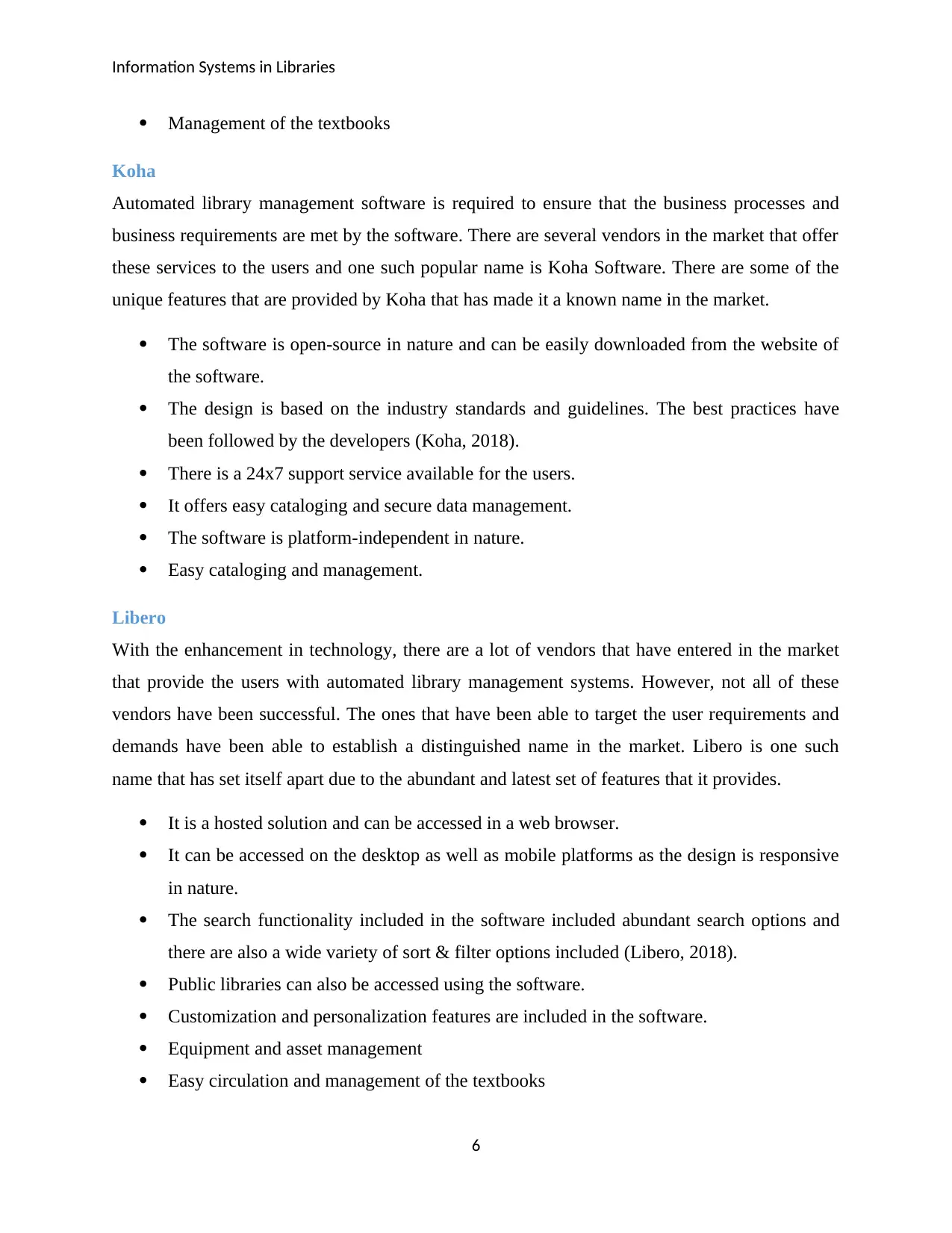
Information Systems in Libraries
Management of the textbooks
Koha
Automated library management software is required to ensure that the business processes and
business requirements are met by the software. There are several vendors in the market that offer
these services to the users and one such popular name is Koha Software. There are some of the
unique features that are provided by Koha that has made it a known name in the market.
The software is open-source in nature and can be easily downloaded from the website of
the software.
The design is based on the industry standards and guidelines. The best practices have
been followed by the developers (Koha, 2018).
There is a 24x7 support service available for the users.
It offers easy cataloging and secure data management.
The software is platform-independent in nature.
Easy cataloging and management.
Libero
With the enhancement in technology, there are a lot of vendors that have entered in the market
that provide the users with automated library management systems. However, not all of these
vendors have been successful. The ones that have been able to target the user requirements and
demands have been able to establish a distinguished name in the market. Libero is one such
name that has set itself apart due to the abundant and latest set of features that it provides.
It is a hosted solution and can be accessed in a web browser.
It can be accessed on the desktop as well as mobile platforms as the design is responsive
in nature.
The search functionality included in the software included abundant search options and
there are also a wide variety of sort & filter options included (Libero, 2018).
Public libraries can also be accessed using the software.
Customization and personalization features are included in the software.
Equipment and asset management
Easy circulation and management of the textbooks
6
Management of the textbooks
Koha
Automated library management software is required to ensure that the business processes and
business requirements are met by the software. There are several vendors in the market that offer
these services to the users and one such popular name is Koha Software. There are some of the
unique features that are provided by Koha that has made it a known name in the market.
The software is open-source in nature and can be easily downloaded from the website of
the software.
The design is based on the industry standards and guidelines. The best practices have
been followed by the developers (Koha, 2018).
There is a 24x7 support service available for the users.
It offers easy cataloging and secure data management.
The software is platform-independent in nature.
Easy cataloging and management.
Libero
With the enhancement in technology, there are a lot of vendors that have entered in the market
that provide the users with automated library management systems. However, not all of these
vendors have been successful. The ones that have been able to target the user requirements and
demands have been able to establish a distinguished name in the market. Libero is one such
name that has set itself apart due to the abundant and latest set of features that it provides.
It is a hosted solution and can be accessed in a web browser.
It can be accessed on the desktop as well as mobile platforms as the design is responsive
in nature.
The search functionality included in the software included abundant search options and
there are also a wide variety of sort & filter options included (Libero, 2018).
Public libraries can also be accessed using the software.
Customization and personalization features are included in the software.
Equipment and asset management
Easy circulation and management of the textbooks
6
Paraphrase This Document
Need a fresh take? Get an instant paraphrase of this document with our AI Paraphraser
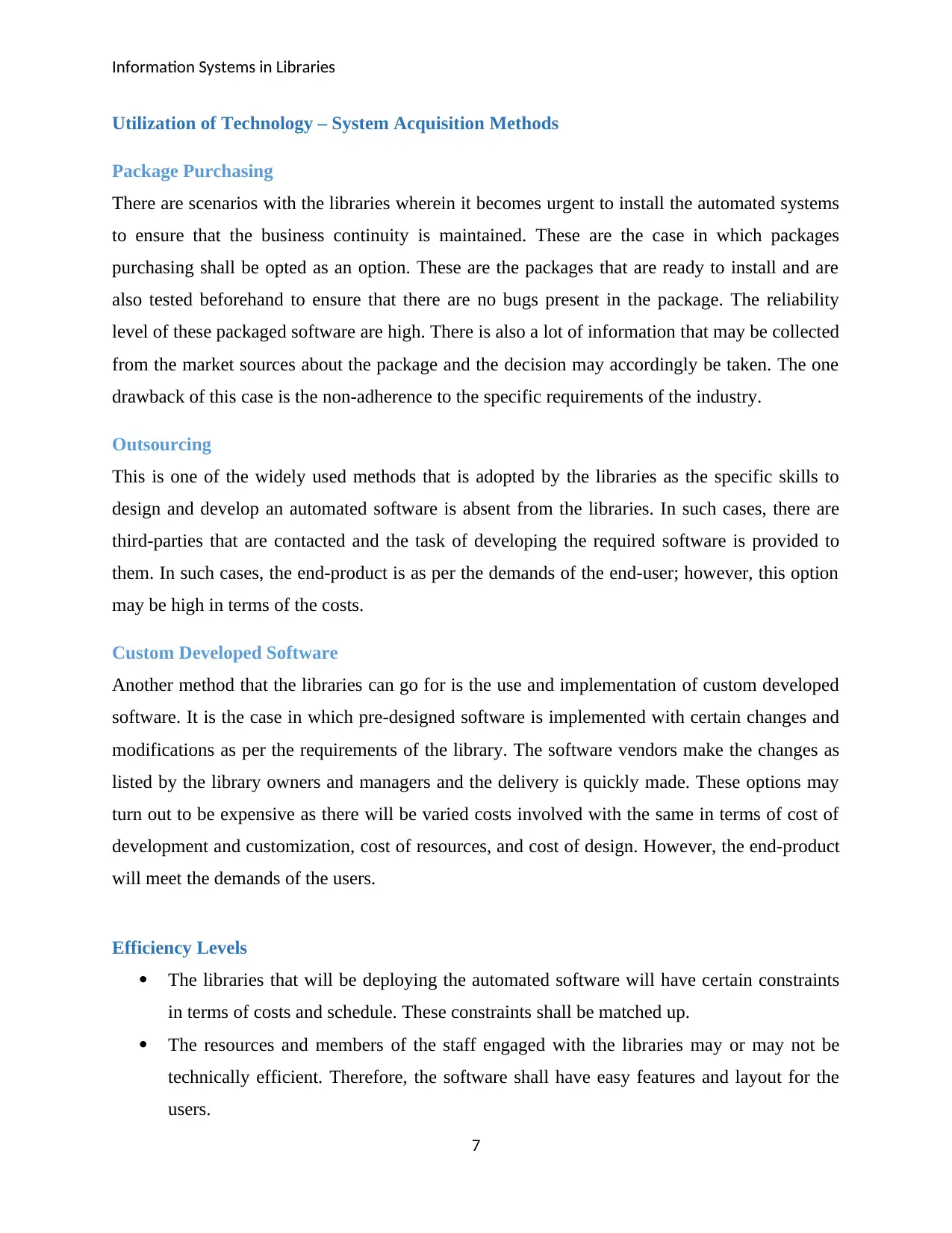
Information Systems in Libraries
Utilization of Technology – System Acquisition Methods
Package Purchasing
There are scenarios with the libraries wherein it becomes urgent to install the automated systems
to ensure that the business continuity is maintained. These are the case in which packages
purchasing shall be opted as an option. These are the packages that are ready to install and are
also tested beforehand to ensure that there are no bugs present in the package. The reliability
level of these packaged software are high. There is also a lot of information that may be collected
from the market sources about the package and the decision may accordingly be taken. The one
drawback of this case is the non-adherence to the specific requirements of the industry.
Outsourcing
This is one of the widely used methods that is adopted by the libraries as the specific skills to
design and develop an automated software is absent from the libraries. In such cases, there are
third-parties that are contacted and the task of developing the required software is provided to
them. In such cases, the end-product is as per the demands of the end-user; however, this option
may be high in terms of the costs.
Custom Developed Software
Another method that the libraries can go for is the use and implementation of custom developed
software. It is the case in which pre-designed software is implemented with certain changes and
modifications as per the requirements of the library. The software vendors make the changes as
listed by the library owners and managers and the delivery is quickly made. These options may
turn out to be expensive as there will be varied costs involved with the same in terms of cost of
development and customization, cost of resources, and cost of design. However, the end-product
will meet the demands of the users.
Efficiency Levels
The libraries that will be deploying the automated software will have certain constraints
in terms of costs and schedule. These constraints shall be matched up.
The resources and members of the staff engaged with the libraries may or may not be
technically efficient. Therefore, the software shall have easy features and layout for the
users.
7
Utilization of Technology – System Acquisition Methods
Package Purchasing
There are scenarios with the libraries wherein it becomes urgent to install the automated systems
to ensure that the business continuity is maintained. These are the case in which packages
purchasing shall be opted as an option. These are the packages that are ready to install and are
also tested beforehand to ensure that there are no bugs present in the package. The reliability
level of these packaged software are high. There is also a lot of information that may be collected
from the market sources about the package and the decision may accordingly be taken. The one
drawback of this case is the non-adherence to the specific requirements of the industry.
Outsourcing
This is one of the widely used methods that is adopted by the libraries as the specific skills to
design and develop an automated software is absent from the libraries. In such cases, there are
third-parties that are contacted and the task of developing the required software is provided to
them. In such cases, the end-product is as per the demands of the end-user; however, this option
may be high in terms of the costs.
Custom Developed Software
Another method that the libraries can go for is the use and implementation of custom developed
software. It is the case in which pre-designed software is implemented with certain changes and
modifications as per the requirements of the library. The software vendors make the changes as
listed by the library owners and managers and the delivery is quickly made. These options may
turn out to be expensive as there will be varied costs involved with the same in terms of cost of
development and customization, cost of resources, and cost of design. However, the end-product
will meet the demands of the users.
Efficiency Levels
The libraries that will be deploying the automated software will have certain constraints
in terms of costs and schedule. These constraints shall be matched up.
The resources and members of the staff engaged with the libraries may or may not be
technically efficient. Therefore, the software shall have easy features and layout for the
users.
7
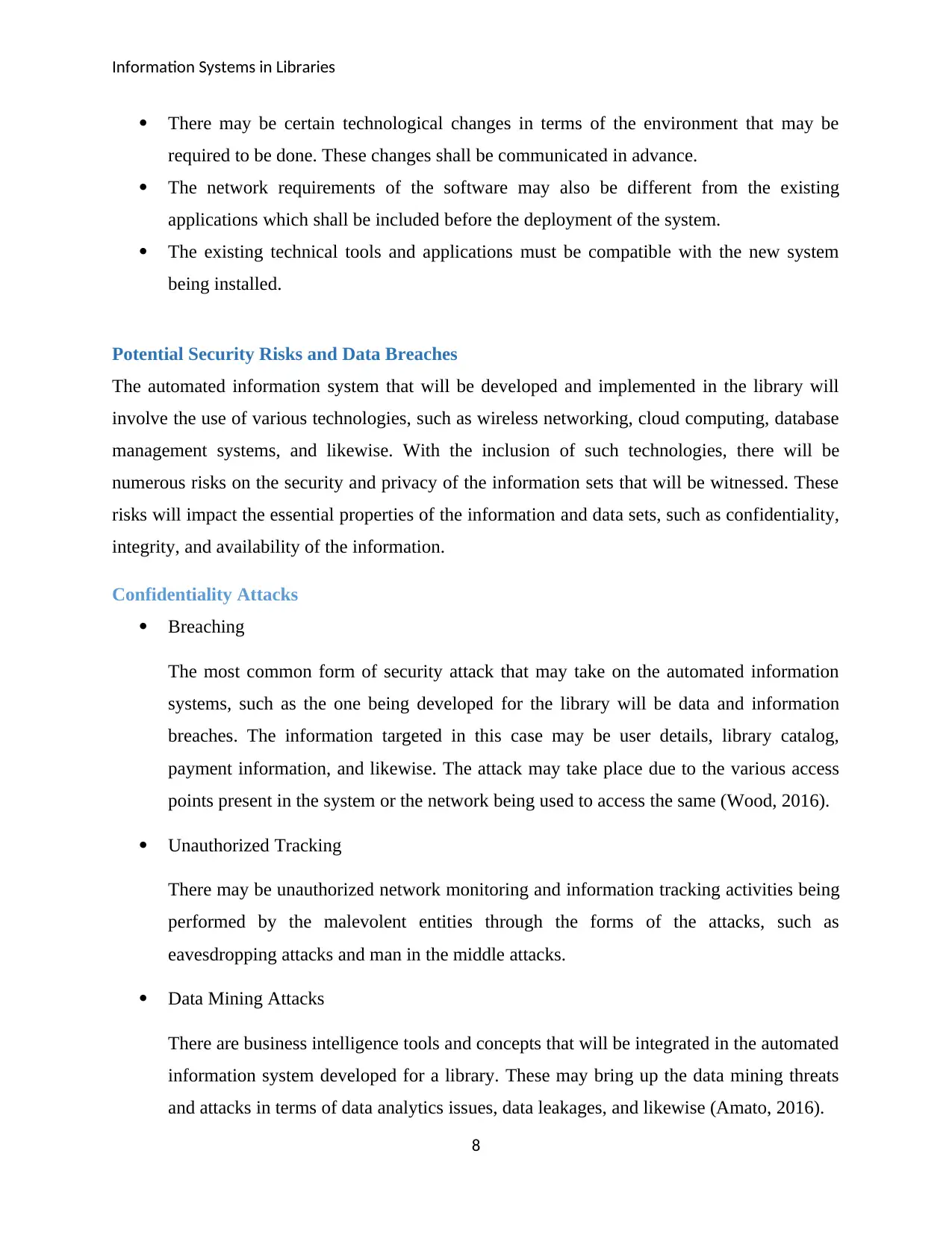
Information Systems in Libraries
There may be certain technological changes in terms of the environment that may be
required to be done. These changes shall be communicated in advance.
The network requirements of the software may also be different from the existing
applications which shall be included before the deployment of the system.
The existing technical tools and applications must be compatible with the new system
being installed.
Potential Security Risks and Data Breaches
The automated information system that will be developed and implemented in the library will
involve the use of various technologies, such as wireless networking, cloud computing, database
management systems, and likewise. With the inclusion of such technologies, there will be
numerous risks on the security and privacy of the information sets that will be witnessed. These
risks will impact the essential properties of the information and data sets, such as confidentiality,
integrity, and availability of the information.
Confidentiality Attacks
Breaching
The most common form of security attack that may take on the automated information
systems, such as the one being developed for the library will be data and information
breaches. The information targeted in this case may be user details, library catalog,
payment information, and likewise. The attack may take place due to the various access
points present in the system or the network being used to access the same (Wood, 2016).
Unauthorized Tracking
There may be unauthorized network monitoring and information tracking activities being
performed by the malevolent entities through the forms of the attacks, such as
eavesdropping attacks and man in the middle attacks.
Data Mining Attacks
There are business intelligence tools and concepts that will be integrated in the automated
information system developed for a library. These may bring up the data mining threats
and attacks in terms of data analytics issues, data leakages, and likewise (Amato, 2016).
8
There may be certain technological changes in terms of the environment that may be
required to be done. These changes shall be communicated in advance.
The network requirements of the software may also be different from the existing
applications which shall be included before the deployment of the system.
The existing technical tools and applications must be compatible with the new system
being installed.
Potential Security Risks and Data Breaches
The automated information system that will be developed and implemented in the library will
involve the use of various technologies, such as wireless networking, cloud computing, database
management systems, and likewise. With the inclusion of such technologies, there will be
numerous risks on the security and privacy of the information sets that will be witnessed. These
risks will impact the essential properties of the information and data sets, such as confidentiality,
integrity, and availability of the information.
Confidentiality Attacks
Breaching
The most common form of security attack that may take on the automated information
systems, such as the one being developed for the library will be data and information
breaches. The information targeted in this case may be user details, library catalog,
payment information, and likewise. The attack may take place due to the various access
points present in the system or the network being used to access the same (Wood, 2016).
Unauthorized Tracking
There may be unauthorized network monitoring and information tracking activities being
performed by the malevolent entities through the forms of the attacks, such as
eavesdropping attacks and man in the middle attacks.
Data Mining Attacks
There are business intelligence tools and concepts that will be integrated in the automated
information system developed for a library. These may bring up the data mining threats
and attacks in terms of data analytics issues, data leakages, and likewise (Amato, 2016).
8
⊘ This is a preview!⊘
Do you want full access?
Subscribe today to unlock all pages.

Trusted by 1+ million students worldwide
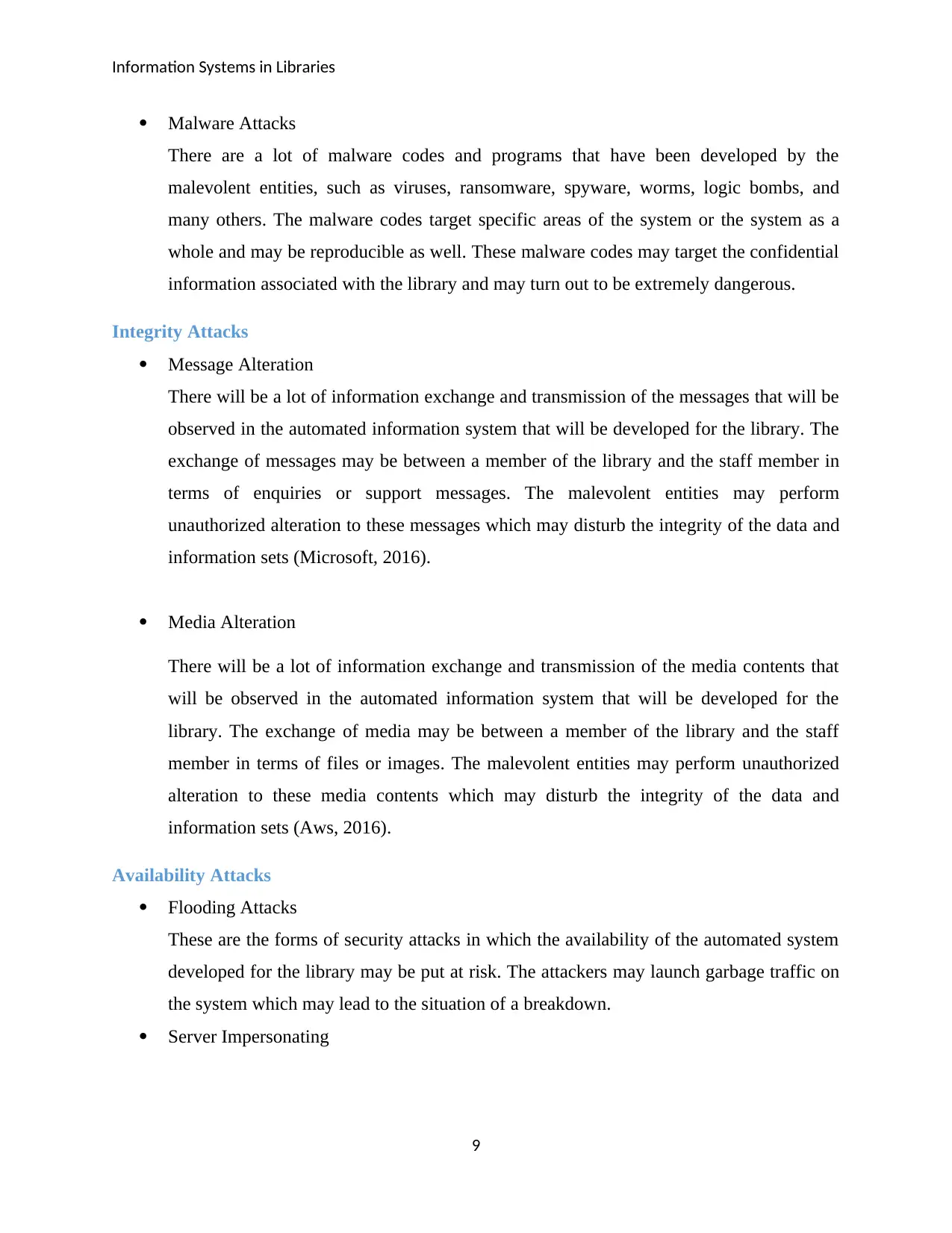
Information Systems in Libraries
Malware Attacks
There are a lot of malware codes and programs that have been developed by the
malevolent entities, such as viruses, ransomware, spyware, worms, logic bombs, and
many others. The malware codes target specific areas of the system or the system as a
whole and may be reproducible as well. These malware codes may target the confidential
information associated with the library and may turn out to be extremely dangerous.
Integrity Attacks
Message Alteration
There will be a lot of information exchange and transmission of the messages that will be
observed in the automated information system that will be developed for the library. The
exchange of messages may be between a member of the library and the staff member in
terms of enquiries or support messages. The malevolent entities may perform
unauthorized alteration to these messages which may disturb the integrity of the data and
information sets (Microsoft, 2016).
Media Alteration
There will be a lot of information exchange and transmission of the media contents that
will be observed in the automated information system that will be developed for the
library. The exchange of media may be between a member of the library and the staff
member in terms of files or images. The malevolent entities may perform unauthorized
alteration to these media contents which may disturb the integrity of the data and
information sets (Aws, 2016).
Availability Attacks
Flooding Attacks
These are the forms of security attacks in which the availability of the automated system
developed for the library may be put at risk. The attackers may launch garbage traffic on
the system which may lead to the situation of a breakdown.
Server Impersonating
9
Malware Attacks
There are a lot of malware codes and programs that have been developed by the
malevolent entities, such as viruses, ransomware, spyware, worms, logic bombs, and
many others. The malware codes target specific areas of the system or the system as a
whole and may be reproducible as well. These malware codes may target the confidential
information associated with the library and may turn out to be extremely dangerous.
Integrity Attacks
Message Alteration
There will be a lot of information exchange and transmission of the messages that will be
observed in the automated information system that will be developed for the library. The
exchange of messages may be between a member of the library and the staff member in
terms of enquiries or support messages. The malevolent entities may perform
unauthorized alteration to these messages which may disturb the integrity of the data and
information sets (Microsoft, 2016).
Media Alteration
There will be a lot of information exchange and transmission of the media contents that
will be observed in the automated information system that will be developed for the
library. The exchange of media may be between a member of the library and the staff
member in terms of files or images. The malevolent entities may perform unauthorized
alteration to these media contents which may disturb the integrity of the data and
information sets (Aws, 2016).
Availability Attacks
Flooding Attacks
These are the forms of security attacks in which the availability of the automated system
developed for the library may be put at risk. The attackers may launch garbage traffic on
the system which may lead to the situation of a breakdown.
Server Impersonating
9
Paraphrase This Document
Need a fresh take? Get an instant paraphrase of this document with our AI Paraphraser
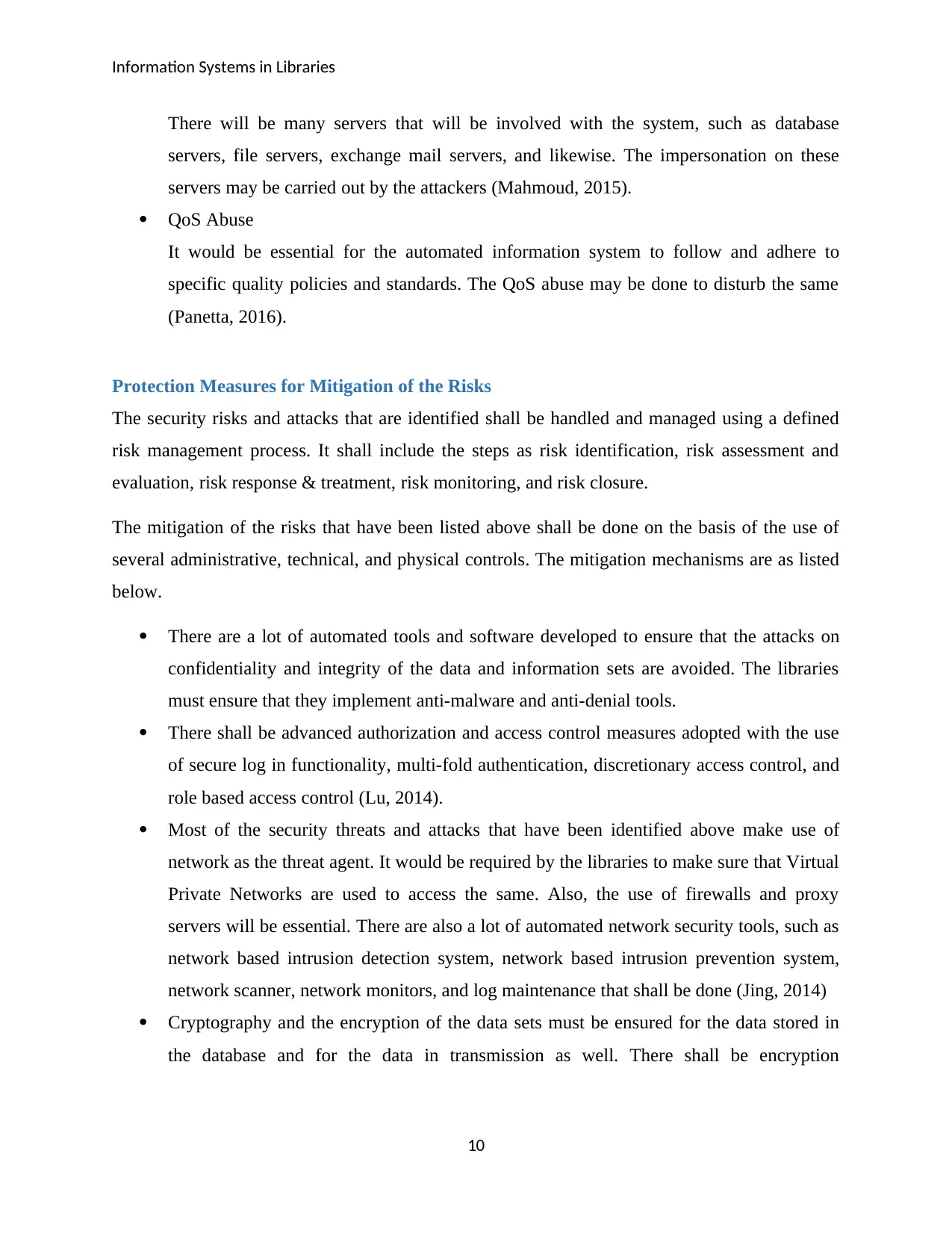
Information Systems in Libraries
There will be many servers that will be involved with the system, such as database
servers, file servers, exchange mail servers, and likewise. The impersonation on these
servers may be carried out by the attackers (Mahmoud, 2015).
QoS Abuse
It would be essential for the automated information system to follow and adhere to
specific quality policies and standards. The QoS abuse may be done to disturb the same
(Panetta, 2016).
Protection Measures for Mitigation of the Risks
The security risks and attacks that are identified shall be handled and managed using a defined
risk management process. It shall include the steps as risk identification, risk assessment and
evaluation, risk response & treatment, risk monitoring, and risk closure.
The mitigation of the risks that have been listed above shall be done on the basis of the use of
several administrative, technical, and physical controls. The mitigation mechanisms are as listed
below.
There are a lot of automated tools and software developed to ensure that the attacks on
confidentiality and integrity of the data and information sets are avoided. The libraries
must ensure that they implement anti-malware and anti-denial tools.
There shall be advanced authorization and access control measures adopted with the use
of secure log in functionality, multi-fold authentication, discretionary access control, and
role based access control (Lu, 2014).
Most of the security threats and attacks that have been identified above make use of
network as the threat agent. It would be required by the libraries to make sure that Virtual
Private Networks are used to access the same. Also, the use of firewalls and proxy
servers will be essential. There are also a lot of automated network security tools, such as
network based intrusion detection system, network based intrusion prevention system,
network scanner, network monitors, and log maintenance that shall be done (Jing, 2014)
Cryptography and the encryption of the data sets must be ensured for the data stored in
the database and for the data in transmission as well. There shall be encryption
10
There will be many servers that will be involved with the system, such as database
servers, file servers, exchange mail servers, and likewise. The impersonation on these
servers may be carried out by the attackers (Mahmoud, 2015).
QoS Abuse
It would be essential for the automated information system to follow and adhere to
specific quality policies and standards. The QoS abuse may be done to disturb the same
(Panetta, 2016).
Protection Measures for Mitigation of the Risks
The security risks and attacks that are identified shall be handled and managed using a defined
risk management process. It shall include the steps as risk identification, risk assessment and
evaluation, risk response & treatment, risk monitoring, and risk closure.
The mitigation of the risks that have been listed above shall be done on the basis of the use of
several administrative, technical, and physical controls. The mitigation mechanisms are as listed
below.
There are a lot of automated tools and software developed to ensure that the attacks on
confidentiality and integrity of the data and information sets are avoided. The libraries
must ensure that they implement anti-malware and anti-denial tools.
There shall be advanced authorization and access control measures adopted with the use
of secure log in functionality, multi-fold authentication, discretionary access control, and
role based access control (Lu, 2014).
Most of the security threats and attacks that have been identified above make use of
network as the threat agent. It would be required by the libraries to make sure that Virtual
Private Networks are used to access the same. Also, the use of firewalls and proxy
servers will be essential. There are also a lot of automated network security tools, such as
network based intrusion detection system, network based intrusion prevention system,
network scanner, network monitors, and log maintenance that shall be done (Jing, 2014)
Cryptography and the encryption of the data sets must be ensured for the data stored in
the database and for the data in transmission as well. There shall be encryption
10
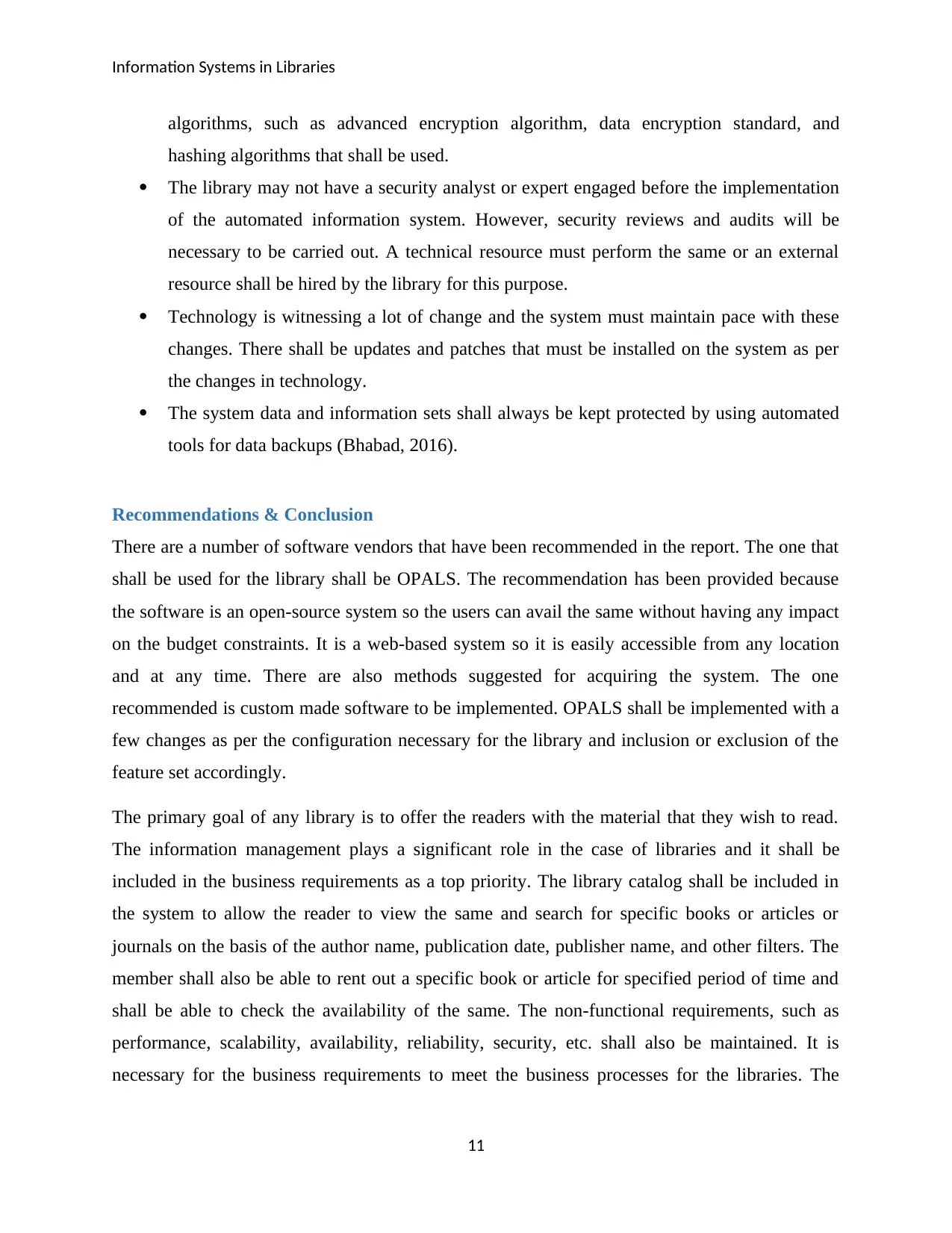
Information Systems in Libraries
algorithms, such as advanced encryption algorithm, data encryption standard, and
hashing algorithms that shall be used.
The library may not have a security analyst or expert engaged before the implementation
of the automated information system. However, security reviews and audits will be
necessary to be carried out. A technical resource must perform the same or an external
resource shall be hired by the library for this purpose.
Technology is witnessing a lot of change and the system must maintain pace with these
changes. There shall be updates and patches that must be installed on the system as per
the changes in technology.
The system data and information sets shall always be kept protected by using automated
tools for data backups (Bhabad, 2016).
Recommendations & Conclusion
There are a number of software vendors that have been recommended in the report. The one that
shall be used for the library shall be OPALS. The recommendation has been provided because
the software is an open-source system so the users can avail the same without having any impact
on the budget constraints. It is a web-based system so it is easily accessible from any location
and at any time. There are also methods suggested for acquiring the system. The one
recommended is custom made software to be implemented. OPALS shall be implemented with a
few changes as per the configuration necessary for the library and inclusion or exclusion of the
feature set accordingly.
The primary goal of any library is to offer the readers with the material that they wish to read.
The information management plays a significant role in the case of libraries and it shall be
included in the business requirements as a top priority. The library catalog shall be included in
the system to allow the reader to view the same and search for specific books or articles or
journals on the basis of the author name, publication date, publisher name, and other filters. The
member shall also be able to rent out a specific book or article for specified period of time and
shall be able to check the availability of the same. The non-functional requirements, such as
performance, scalability, availability, reliability, security, etc. shall also be maintained. It is
necessary for the business requirements to meet the business processes for the libraries. The
11
algorithms, such as advanced encryption algorithm, data encryption standard, and
hashing algorithms that shall be used.
The library may not have a security analyst or expert engaged before the implementation
of the automated information system. However, security reviews and audits will be
necessary to be carried out. A technical resource must perform the same or an external
resource shall be hired by the library for this purpose.
Technology is witnessing a lot of change and the system must maintain pace with these
changes. There shall be updates and patches that must be installed on the system as per
the changes in technology.
The system data and information sets shall always be kept protected by using automated
tools for data backups (Bhabad, 2016).
Recommendations & Conclusion
There are a number of software vendors that have been recommended in the report. The one that
shall be used for the library shall be OPALS. The recommendation has been provided because
the software is an open-source system so the users can avail the same without having any impact
on the budget constraints. It is a web-based system so it is easily accessible from any location
and at any time. There are also methods suggested for acquiring the system. The one
recommended is custom made software to be implemented. OPALS shall be implemented with a
few changes as per the configuration necessary for the library and inclusion or exclusion of the
feature set accordingly.
The primary goal of any library is to offer the readers with the material that they wish to read.
The information management plays a significant role in the case of libraries and it shall be
included in the business requirements as a top priority. The library catalog shall be included in
the system to allow the reader to view the same and search for specific books or articles or
journals on the basis of the author name, publication date, publisher name, and other filters. The
member shall also be able to rent out a specific book or article for specified period of time and
shall be able to check the availability of the same. The non-functional requirements, such as
performance, scalability, availability, reliability, security, etc. shall also be maintained. It is
necessary for the business requirements to meet the business processes for the libraries. The
11
⊘ This is a preview!⊘
Do you want full access?
Subscribe today to unlock all pages.

Trusted by 1+ million students worldwide
1 out of 15
Related Documents
Your All-in-One AI-Powered Toolkit for Academic Success.
+13062052269
info@desklib.com
Available 24*7 on WhatsApp / Email
![[object Object]](/_next/static/media/star-bottom.7253800d.svg)
Unlock your academic potential
Copyright © 2020–2025 A2Z Services. All Rights Reserved. Developed and managed by ZUCOL.





